How to grow tulips in a pot at home
Most people associate tulips with spring and the holiday of March 8th. They are one of the first to bloom after winter. Tulips are often found on store shelves even out of season.
Usually, for the holidays, flowers are grown in large quantities in a greenhouse, where it is easy to create suitable conditions for the plants. However, it is possible to grow tulips in a pot at home even without special equipment. The main thing is to know the basic nuances of agricultural technology, correctly calculate the planting time and observe the temperature regime.
Is it possible to grow tulips at home in a pot?
Although tulips are not indoor plants, you can grow them on a windowsill or balcony all year round. To produce large quantities of flowers for sale, you will need a greenhouse, but several pots of plants can easily be obtained at home.
It is important to properly prepare the bulbs for planting and maintain temperature conditions throughout the entire cultivation.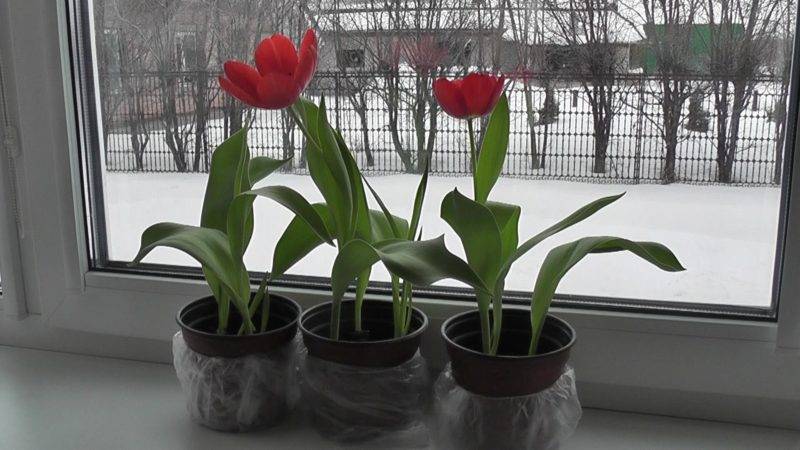
Selecting suitable varieties
Not all varieties are suitable for growing tulips in pots. They must meet a number of requirements:
- Size. Low-growing or medium-growing varieties are suitable for forcing at home. Larger specimens will have little space in the planting containers.
- Timing for discarding flowers. Early varieties are preferred - this will allow you to get buds as early as possible.
- Characteristics. Simple and double tulips, plants with large and small buds, single-colored and multi-colored are suitable for growing on a windowsill.It is advisable to buy plants that are resistant to disease and cold.
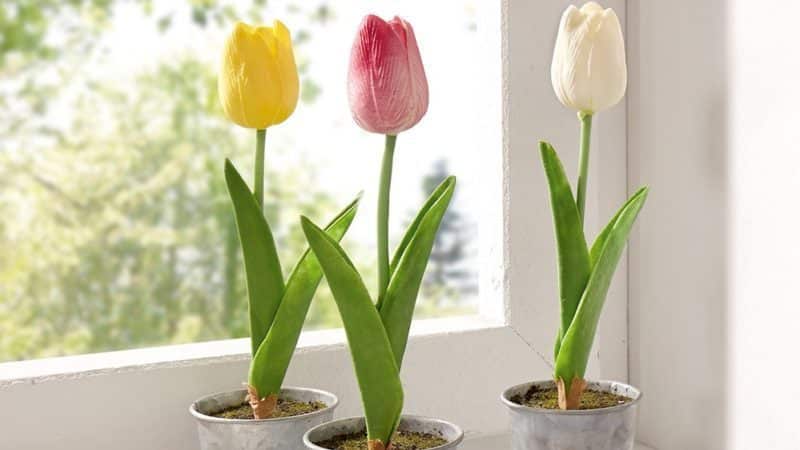
There are many varieties suitable for forcing at home. These include:
- Apricot Beauty;
- Parade Record;
- Miles Bridge;
- Aristocrat;
- Fringed Elegance;
- Negrita;
- Confux;
- Lustige Witve;
- Christmas Marvel;
- Temple of Beauty;
- Scarborough;
- Eric Hofsue;
- Apeldoorn;
- London.
These varieties are suitable for growing even on a window in spring, summer, winter and autumn. They meet all the specified characteristics and are easy to care for.
Attention! It is not advisable to choose exotic varieties with an unusual color (brown, purple, etc.). They are demanding of care, and growing them at home will be difficult.
Bulb selection

It is important to choose not only a suitable variety, but also planting material. The quality of the bulbs determines whether they will germinate and whether the plants will get sick. Pay attention to the following parameters:
- Size. The ideal bulb diameter is 3-4 cm. Smaller planting material will take a long time to germinate. Children are not suitable for forcing out.
- Density. The bulbs should be firm to the touch. If juice comes out when pressed, it means the planting material is spoiled. The suspiciously low weight also indicates low quality.
- Scales. Brown, not very dark shade. Elastic to the touch. The shell of the bulbs that were left in the ground is too dense and hard.
- Appearance. The bulbs should be free of stains, mold and other signs of infection. The absence of serious damage is also important. The planting material should be smooth to the touch. Select specimens of round shape and uniform color.
- Dontse. Dense and hard to the touch. The presence of tubercles is required, from which the roots emerge.
- Stem. Only a small tip should be visible from the bulb. It is important that there are no stains, mold or damage on it.
Pay attention to these signs both when purchasing and when independently collecting planting material. In the second case, it is important to know how to get high-quality bulbs:
- The buds are cut off immediately after they open, not earlier.
- The bulbs are dug up when the stems and leaves of the plant turn yellow.
- When growing tulips, they feed them. This ensures the supply of sufficient nutrients to the planting material.
Bulbs are purchased from July to September. During this period, it will be possible to obtain the highest quality copies and have time to prepare them.
Optimal growing conditions
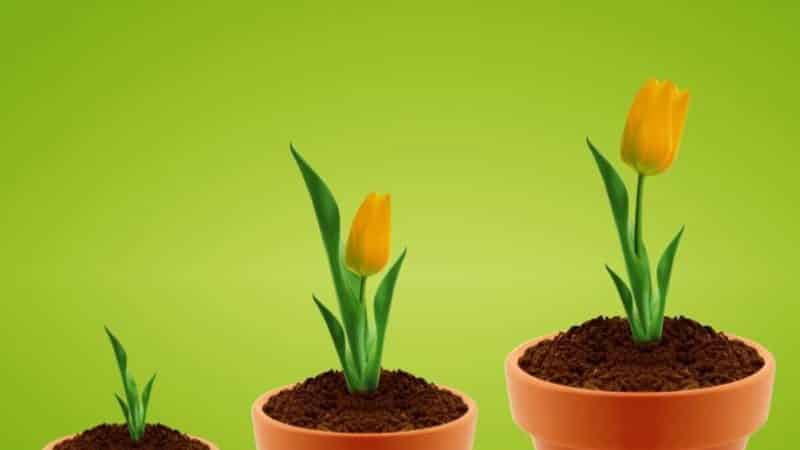
In order for tulips to develop properly and the buds to turn out high-quality and bright, it is important to provide the plants with optimal conditions:
- Temperature. At the initial stage of planting, tulips are placed in a place with a temperature of +7°C. When the shoots appear, the pots are brought into a room with temperatures of +12...+18°C. At lower and higher values, the buds will not be as beautiful. If the fluctuations are significant, the plants will begin to hurt.
- Lighting. If daylight hours last less than 12 hours, it is recommended to use backlighting. It is advisable to choose special phytolamps. In winter, daylight hours for tulips last 9 hours. Until germination, plants are kept in a dark room. With a lack of light, the flowers turn out pale.
- Humidity. The optimal indicator for the crop is 80%. In winter, if the room is heated, use a humidifier to create optimal conditions.
It is not difficult to create optimal conditions for growing tulips in an apartment.Although these colors often require additional lighting, it does not need to be very bright.
Advice. If you don’t have a humidifier, place a damp cloth on the heater and make sure it doesn’t dry out.
Choosing a place for forcing
Usually flowers are placed on the windowsill, since near the window the plant is illuminated by the sun. In this case, you cannot open the window during cultivation, since tulips cannot tolerate drafts.
If there are several lighting fixtures for plants, the pots are placed in any other place in the apartment. Containers should be located at the maximum distance from heating devices.
It is best to grow tulips on a glass heated balcony. In this case, you won’t even need lighting fixtures if the plants have enough natural light.
Preparatory work
Before growing tulips at home, a number of preparatory work is carried out. Whether the plant will bloom by the right time depends on how correctly they are performed.
Planting material
Preparing planting material is the most important part of growing tulips. They begin to work with bulbs immediately after purchase or collection. Follow step by step instructions:
- Calibration The bulbs are sorted by size, putting large ones in one pile and small ones in another. The finer the planting material, the later it will germinate.
- Temperature fluctuations. The planting material is first kept at a temperature of +30°C, then the indicators are reduced to +9°C. In such conditions (usually in the vegetable section of the refrigerator), the bulbs are stored until planting.
- Cleaning. The bulbs are peeled and checked for mold and dark spots.
- Disinfection. Planting material is soaked for half an hour in a light pink solution of potassium permanganate.
Container and soil

To grow tulips, it is important to choose the right container. The bulbs are planted close to each other, the width of the container is determined depending on the number of bulbs.
It is not recommended to plant tulips in deep pots. For large specimens, choose a container with a depth of 30 cm, for small ones - 20 cm.
Ceramic pots are best suited for flowers. They allow air to pass through and are saturated with moisture, preventing the soil from drying out and reducing the likelihood of liquid stagnation. Plastic containers do not have this property.
Important! There must be drainage holes in the bottom of the container.
Soil options:
- Hydrogel. The substance absorbs moisture, so plant roots constantly receive the optimal amount of liquid. The filler comes in different shades and looks attractive even in transparent containers. If tulips are grown for sale, this soil option is not suitable due to the high costs.
- Sand. In such a substrate the risks of moisture stagnation are minimal. However, the liquid here evaporates too quickly. A lot of attention will have to be paid to fertilizing.
- Soil mixture. This is the best option for growing tulips at home. To prepare the soil, peat, sand and garden soil are mixed in equal proportions.
- Water. Tulips can also be grown in water, but in this case the risk of bulb rotting increases.
The soil and containers are disinfected: poured with boiling water or a dark pink solution of potassium permanganate.
Planting dates and technology
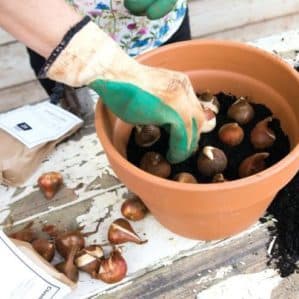
Tulips are grown at home all year round. To get the buds out by the right time, it is important to correctly calculate the planting time.On average, 3-4 weeks pass before rooting, and 16-18 weeks from rooting to flowering. These dates are given for early tulips; for later varieties the indicators change.
To calculate the planting date from the time by which they should bloom, take away the rooting time and the period from it to flowering. There are average landing times for major holidays:
- for the New Year and Christmas - in the first half of September;
- for Valentine's Day - in mid-October;
- by March 8 - late October or early November.
In a pot, tulips bloom for more than 2 weeks. Cut buds remain fresh for no more than a week.
This is interesting! Stores sell bulbs ready for forcing. They are planted in the ground immediately after purchase.
Before planting tulips, prepare the bulbs, soil and containers. Then we begin to root the plants:
- A layer of drainage is poured onto the bottom of the container. 2/3 of the volume is filled with soil.
- The bulbs are placed at a distance of 2-3 cm from each other. Some gardeners plant them close to each other. The planting material is lightly pressed into the ground.
- The bulbs are completely covered with soil. The soil is moistened with water at room temperature.
Until the first shoots appear, the containers are kept at a temperature of +8...+10°C and a humidity of 75%. When the planting material germinates, the temperature is reduced to +1...+3°C.
3 weeks before the expected flowering, the tulips are moved to a dark room with a temperature of +14°C. After 4 days, the plants are transferred to a bright place (or additional lighting devices are turned on) with a temperature of +18°C.
Further care
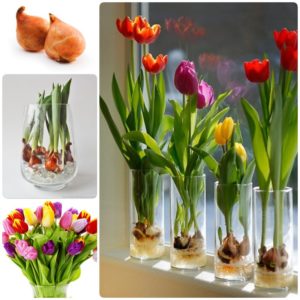
Caring for tulips does not take much time. It consists of timely watering and fertilizing.
Plants are moistened every day, morning or evening. Use settled water at a temperature of +8…+12°C. It is not poured on leaves, peduncles and stems of plants.
For the first 2 weeks, regular watering is alternated with the addition of a calcium nitrate solution (20 g of the drug per 10 liters of water). Twice during the entire growing period, tulips are fed with special fertilizers for bulbous plants, diluted according to the instructions.
It is important not to use concentrations higher than recommended doses and not to apply fertilizer too frequently. This will damage the roots and reduce the chances of the plants flowering.
Possible difficulties
At home, tulips rarely get sick if the soil, bulbs and containers have been treated. Pests do not fly into the apartment in winter.
Although caring for tulips is not difficult, novice gardeners often make mistakes. This causes the following problems:
- The buds are dry and feel like paper. This problem occurs when there is not enough fresh air or the temperature is too high.
- Drooping flower stalks indicate elevated temperatures in the place where the tulips are grown.
- Weak flower stalks are a sign of calcium deficiency.
- Planting material does not take root. The problem occurs when air humidity is low.
- The bulbs rot if the tulips are watered with warm water.
- Tulips do not form flower stalks. This indicates that too fine planting material was used.
If the described problems occur, all negative factors are eliminated. Usually this is enough to restore proper plant development.
Methods for propagating tulips
The fastest and easiest way to propagate is by bulbs. In the roots of the plant, children are formed, which are separated from the main plant and used for breeding tulips.
Less commonly, flowers are propagated by seeds.In this case, 3 years pass from sowing to flowering.
Advice from experienced flower growers

Recommendations for growing tulips at home:
- To speed up flowering by 2-3 days, the room temperature is raised to +20°C 3 days before the desired time for buds to appear, and the soil is moistened with water at room temperature.
- Bulbs with different periods of ejection of flower stalks are planted in a pot in layers. The later the flowering period, the deeper the planting material is buried.
- To obtain good material for the next planting, tulips continue to be cared for even after cutting off the flower stalks.
Read also:
How dangerous are aphids on petunia and how to effectively fight them
Is it possible to grow petunia in a pot as a houseplant?
Description of varieties and features of growing terry petunia
Conclusion
Tulip is an unpretentious plant that requires a minimum of care, consisting of timely watering and fertilizing.
It is important to provide the plant with suitable conditions. Most of the time, pots are kept in the basement, on the balcony or in the refrigerator. Only 3 weeks before flowering they are brought indoors. It is important not to forget to use additional lighting devices and a humidifier.